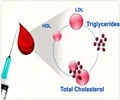Adopting healthy habits in youth is associated with more favourable cholesterol levels in adulthood, a new study has said.

Participants had their cholesterol and triglyceride levels measured in 1985 when they were age 9, 12 or 15, and again at a follow-up between 2004 and 2006 (an average of 20 years later).
High-risk levels were defined as a total cholesterol level of 240 milligrams per deciliter or higher, an LDL or "bad" cholesterol level of 160 milligrams per deciliter or higher, an HDL or "good" cholesterol level of less than 40 milligrams per deciliter or a triglyceride level of 200 milligrams per deciliter or higher.
In addition, their height, weight, waist circumference, skin-fold thickness, smoking behaviors, cardiorespiratory fitness and socioeconomic factors were recorded at both time points.
"Using established cut points, we found that substantial proportions of individuals with high-risk blood lipid and lipoprotein levels at baseline no longer had high-risk levels at follow-up," the authors write.
Advertisement
Participants who had low-risk profiles in youth but became high-risk as adults also had greater increases in body fat, were less likely to improve their socioeconomic conditions and became less fit between measurements than did those who remained low-risk.
Advertisement
"Our findings are important for two reasons. First, they suggest that beneficial changes in modifiable risk factors (smoking and adiposity) in the time between youth and adulthood have the potential to shift those with high-risk blood lipid and lipoprotein levels in youth to low-risk levels in adulthood. Second, they emphasize that preventive programs aimed at those who do not have high-risk blood lipid and lipoprotein levels in youth are equally important if the proportion of adults with high-risk levels is to be reduced."
The study appears in the January issue of Archives of Pediatrics and Adolescent Medicine, one of the JAMA/Archives journals.
Source-ANI















